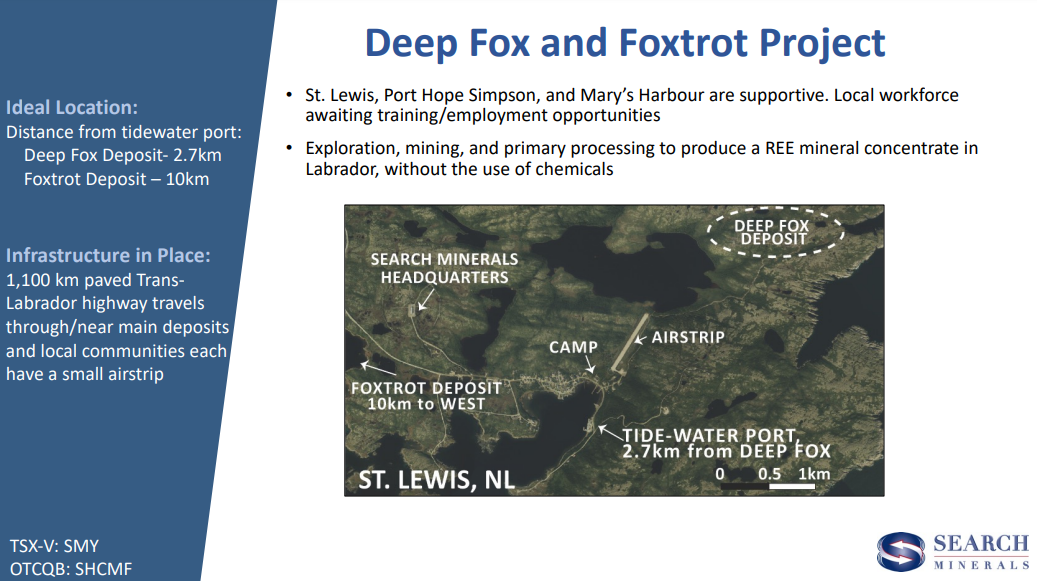Ucore’s rare earths processing technology facility offers Louisiana a blue ribbon opportunity for the critical minerals supply chain
As most readers of InvestorIntel know by now, demand for the magnet rare earths is set to surge this decade as the EV and renewable energy booms takes off. Electric vehicles require the magnet rare earths in their electric motors as do many of the most powerful wind turbines.
The problem right now is that there are no rare earths separation facilities of scale in the USA, meaning the market is reliant on China.
Today’s company is one of very few western companies that is making big moves to change that. Notably to develop rare earths separation facilities in North America.
Ucore Rare Metals Inc. (TSXV: UCU | OTCQX: UURAF) (“Ucore”) 100% own the Bokan-Dotson Ridge REE Project (contains Dysprosium (Dy), Terbium (Tb) & Yttrium (Y)) in Alaska and has plans to build a rare earth separation facility in Louisiana, USA.
Ucore is focused on Rare Earth Oxide separation (production) in North America for both heavy (HREE) and light (LREE) rare earth elements

Source: Ucore company presentation
As announced on November 22, 2022, Ucore is in the process of selecting a site for their Louisiana facility and is choosing between three existing brownfield facilities in Southwest and Central Louisiana. Ucore states that they intend “to select a location in Q1-2023 to maintain the development schedule required by prospective OEM partners.” Ucore indicated that they hope to have the facility in operation by end-2024 (Phase 1 – 2,000 tpa TREO) and Phase 2 (5,000 tpa TREO) by 2026 (see chart on page 11).
Ucore states that the Louisiana separation facility (known as the Louisiana Strategic Metals Complex (“LSMC“)) is being designed to:
- “process 2,000 tonnes of TREO from mixed rare earth concentrates on a per annum basis (“tpa“) in the first and second year of operation, after that, expanding to 5,000 tpa:
- from multiple US-friendly sources, including heavy REE (“HREE“) and light REE (“LREE“) feedstocks.
- initially be capable of processing all RapidSX™ splits required to produce individual praseodymium, neodymium, terbium, and dysprosium from each applicable feedstock source. The product line will expand to other individual rare earth elements as the Western REE market develops.”
The four primary rare earth oxides used to produce NdFeB permanent magnet motors are neodymium, praseodymium, dysprosium, and terbium.
Rapid SXTM technology and demonstration plant commissioning
The LSMC will use Ucore’s 100%-owned Innovation Metals Inc. Rapid SXTM technology which has already been successfully piloted. Ucore states that “RapidSX™ is a transformative REE Separation Technology” that is faster and has a lower CapEx and OpEx than conventional separation technologies. It is also very scalable.
The longer term Ucore plan is to develop several Strategic Metals Complex Facilities (separation facilities) across North America.
The demonstration plant work is a focus for early 2023. Last month Ucore announced that:
“Commissioning will take place over the next several months. A program designed to demonstrate the significant advantages of utilizing its RapidSX™ technology platform for separating light and heavy rare earth elements into high-purity individual elements/compounds……..The Demo Plant is designed to process tens of tonnes of HREE and LREE feedstock annually. Once the commissioning trials are completed, the Company is planning two additional 10-ton processing campaigns for the commercial demonstration and products qualification program.”
Usually, once potential off-take partners have qualified the material, it can lead to off-take agreements. This then typically lends support for potential project funding.
Ucore’s next steps and master plan

Source: Ucore company presentation
Project funding – U.S desperately needs to develop rare earths separation facilities
According to Ucore, there is currently no rare earths separation facilities of scale in North America. This would suggest that Ucore may receive some assistance from the U.S. government to get their Louisiana facility funded. Alastair Neill recently pointed out in an InvestorIntel article: “MP received US$35 million and Lynas US$120 million. This begs the question of whether or not the DoD will support Ucore with this plan of action.” Syrah Resources Limited (ASX: SYR), Talon Metals Corp. (TSX: TLO) and Piedmont Lithium Inc. (Nasdaq: PLL | ASX: PLL) are others that have recently received U.S. grants for their spherical graphite processing, nickel processing, and lithium chemical processing plans respectively. There is also the U.S. loans program office that is looking to support critical metals projects in the USA.
The Louisiana Economic Development (“LED”) organization has already stepped up to support Ucore with a non-binding Letter of Intent (“LOI”) for a 10-year US$9.6 million plus tax incentives package (over the first ten years of operation) in consideration for Ucore’s projected investment of US$55 million for the Louisiana facility. There is also an expedited process for all required state permits.
Closing remarks
Ucore still has several hurdles ahead to achieve their goals, but management appears to be laser focused on the task. With some support already from LED and hopefully from the U.S Federal government the future for Ucore is starting to shape up nicely.
Ucore Rare Metals Inc. trades on a market cap of C$53 million and is cashed up after a recent ~C$4.59 million raise in December, 2022. Stay tuned.









